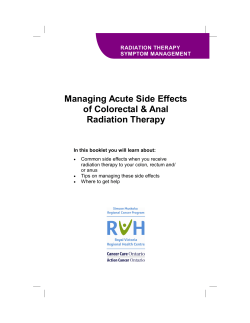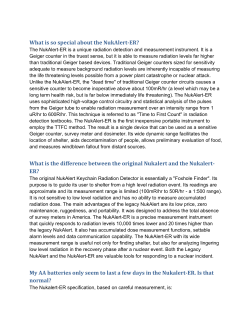
Radiation treatments highly effective in halting growth of acoustic neuromas Outpatient therapies need
Radiation treatments highly effective in halting growth of acoustic neuromas Outpatient therapies need no recovery time “Patients require no recovery time from these stereotactic treatments, and they suffer no disability or decline in quality of life,” says Michael Selch, M.D., professor of radiation oncology at UCLA. “The thing that patients worry about the most — injury to the nerve that controls motor funtion in the face — is extremely uncommon.” Physicians at UCLA are using the latest stereotactic radiation technology to treat acoustic neuromas while preserving hearing and exposing patients to as little risk of nerve damage as possible. In excess of 95 percent of these tumors are successfully treated using non-invasive, outpatient stereotactic radiation treatments. An acoustic neuroma, also known as vestibular schwannoma, is a benign tumor of the auditory nerve. Symptoms include hearing loss, tinnitus, vertigo, facial numbness and facial weakness. If left untreated, these tumors can grow large enough to exert pressure on important brain structures. Radiosurgery and radiotherapy The advanced Novalis Tx™ linear accelerator enables UCLA’s Department of Radiation Oncology to offer both stereotactic radiosurgery (SRS) — delivering a single, very high dose radiation exposure in one session — and stereotactic radiotherapy (SRT), in which smaller, fractionated doses are given on consecutive days over the course of multiple weeks. WWW.UCLAHEALTH.ORG 1-800-UCLA-MD1 (1-800-825-2631) In addition to having a highly experienced team, with essentially the same personnel providing stereotactic radiation and neurosurgery treatments for approximately 20 years, UCLA is among the best equipped center. “Our linear accelerator, Novalis Tx, has the most modern features for effectively immobilizing the patient and putting the radiation beam right on the target,” explains Dr. Selch. “The precision is extraordinary.” “This technology, pioneered and further developed at UCLA, allows better preservation of hearing with multiple fractions of radiation,” explains Antonio De Salles, M.D., professor of neurological surgery. While no treatment for acoustic neuroma can restore hearing that has been lost due to the tumor’s direct damage to the acoustic nerve, the fractionated approach has proven to preserve patients’ remaining hearing more reliably than other treatments. For example, while SRS preserves useful hearing in 70 percent of acoustic neuroma patients, SRT preserves useful hearing in 90 percent of these patients. For this reason, UCLA physicians usually perform SRT in patients who still have useful hearing in the affected ear. While many centers offer SRS — usually via the Gamma Knife or CyberKnife — very few centers in Southern California have the equipment needed to offer the fractionated treatments used in SRT. Unlike the Gamma Knife, Novalis Tx is a “frameless” procedure that is rapid, non-invasive, and comfortable for patients. Participating Physician Antonio De Salles, M.D., Ph.D. Professor of Neurosurgery Michael Selch, M.D. Professor of Radiation Oncology Both stereotactic treatments are nearly free of other side effects. Injury to the 7th nerve, which controls motor function in the face, is extremely rare with stereotactic radiation treatments, and facial numbness following either treatment is extremely rare as well. About the treatment SRS and SRT are both outpatient procedures and are completely painless; patients have no sensation of being irradiated and are able to pursue their normal activities immediately after treatment. The actual administration of the radiation dose takes only a few minutes. For SRT, treatment is usually given five days a week for about 28 sessions. Before treatment begins, patients typically undergo both magnetic resonance imaging (MRI) and computed tomography (CT) studies to determine the exact size, shape and location of the tumor so it can be precisely targeted. During treatment, the radiation source passes around the patient’s head at different angles in a series of arcs. Each individual arc that the radiation source travels gets a very low dose of radiation, but where the arcs intersect the tissue receives a higher amount of precise radiation. The patient wears a custom facemask during the treatments to help maintain proper positioning. For extremely large tumors that are impinging on brain structures, stereotactic radiation can be combined with neurosurgery to relieve the pressure and prevent future tumor growth. The surgeon removes enough of the tumor to alleviate pressure on the brain while the remaining tumor is treated with radiation. UCLA has extensive experience with both microneurosurgical treatment and stereotactic radiotherapy for acoustic neuromas — the optimal choice of therapy is selected for each patient, based on the tumor size and the associated symptoms. After treatment, acoustic neuroma patients are followed up to ensure there is no late tumor growth. Patients are checked with an MRI every six months for the first two years, then annual MRIs after that. Contact Information UCLA Department of Radiation Oncology 200 UCLA Medical Plaza Suite B265 Los Angeles, CA 90095-6951 Radiation Oncology (310) 825-9775 Neurosurgery (310) 794-1221 Fax: (310) 794-9795 www.radonc.ucla.edu WWW.UCLAHEALTH.ORG 1-800-UCLA-MD1 (1-800-825-2631) 10V1-06:04-11
© Copyright 2025





















